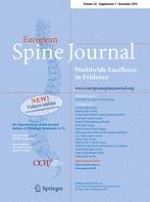Open Access 01-11-2015 | Original Article
Does hybrid fixation prevent junctional disease after posterior fusion for degenerative lumbar disorders? A minimum 5-year follow-up study
Published in: European Spine Journal | Special Issue 7/2015
Login to get accessAbstract
Purpose
Medium- to long-term retrospective evaluation of clinical and radiographic outcome in the treatment of degenerative lumbar diseases with hybrid posterior fixation.
Methods
Thirty patients were included with the mean age of 47.8 years (range 35 to 60 years). All patients underwent posterior lumbar instrumentation using hybrid fixation for lumbar stenosis with instability (13 cases), degenerative spondylolisthesis Meyerding grade I (6 cases), degenerative disc disease of one or more adjacent levels in six cases and mild lumbar degenerative scoliosis in five patients. Clinical outcomes were evaluated using Oswestry disability index (ODI), Roland and Morris disability questionnaire (RMDQ), and the visual analog scale (VAS) pain scores. All patients were assessed by preoperative, postoperative and follow-up standing plain radiographs and lateral X-rays with flexion and extension. Adjacent disc degeneration was also evaluated by magnetic resonance imaging (MRI) at follow-up.
Results
At a mean follow-up of 6.1 years, we observed on X-rays and/or MRI 3 cases of adjacent segment disease (10.0 %): two of them (6.6 %) presented symptoms and recurred a new surgery. The last patient (3.3 %) developed asymptomatic retrolisthesis of L3 not requiring revision surgery. The mean preoperative ODI score was 67.6, RMDQ score was 15.1, VAS back pain score was 9.5, and VAS leg pain score was 8.6. Postoperatively, these values improved to 28.1, 5.4, 3.1, and 2.9, respectively, and remained substantially unchanged at the final follow-up: (27.7, 5.2, 2.9, and 2.7, respectively).
Conclusions
After 5-year follow-up, hybrid posterior lumbar fixation presented satisfying clinical outcomes in the treatment of degenerative disease.





